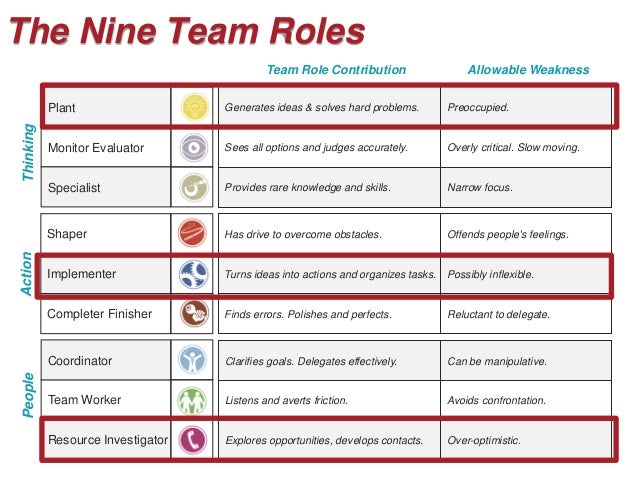

Initial enthusiasm may not be maintained to the end of the project Goes outside the team to bring in ideas, information and developments Quick, good communicator, networker, outgoing, affable, seeks and finds options, negotiator Good at coming up with ideas but may have difficulties communicating them

Innovative, creative, inventive, original, imaginative, unorthodox, problem-solving Sets agenda, clarifies group objectives, and establishes prioritiesĬan sometimes be manipulative and delegate too much work to others May challenge others and be aggressive at timesĬonfident, mature, able to get others to work to a shared aim Gives shape to discussion, looks for pattern and practical considerations and feasibility of the project Motivated, energetic, competitive, achievement driven, assertive May be inflexible and have difficulty changing their well thought out plans Turns decisions into defined tasks, sorts objectives and pursues them logically Systematic, structured, dependable, efficient, common sense, loyal, reliable Table 2 Belbin’s 9 team roles and their likely strengths and weaknesses Strength/style Nevertheless there is enough to commend here for you to take a look at the different roles that Belbin identified and consider how this relates to your own experience of working in a team. As research has shown, some of these roles are not easy to distinguish from others and there are other frameworks to describe personality that may work better for describing recognisable types. It should be noted that there are weaknesses in the framework Belbin has described. Interestingly none of the roles are identified as being better than any other and each role is seen to have strengths and weaknesses associated with it. By ensuring that there is a balance of these roles in a team there is a greater likelihood that the team will perform well. While you can adopt other roles, you will work best when playing one of your preferred roles. He suggests that an individual is more likely to be effective if they play the roles that they are most inclined to play or more skilled at.

There are many different theories of personality styles but one of the most popular and influential that is associated with working in teams is Meredith Belbin’s 9 team roles (2018).īelbin identified nine clusters of behaviour or roles which have been developed and amended over the years.


 0 kommentar(er)
0 kommentar(er)
